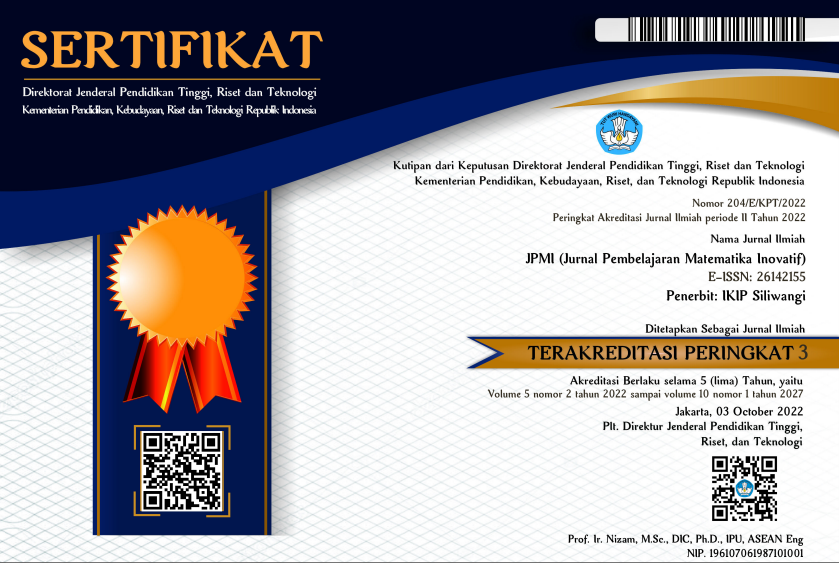KEMAMPUAN BERPIKIR KREATIF TERHADAP PEMECAHAN MASALAH
DOI:
https://doi.org/10.22460/jpmi.v6i1.14565Kata Kunci:
Creative Thinking Ability, Problem Solving, Two Variable Linear EquationsAbstrak
This study aims to determine and describe the ability to think creatively mathematically on solving problems of a two-variable linear equation system at SMK PGRI Pontianak. The method used in this study is a qualitative description. Sources of data in this study were students of class X SMK PGRI Pontianak. The instrument used to conduct the research is a mathematical creative thinking ability test for solving SPLDV problems, namely the fluency indicator is included in the low category with a score of 38% of 13 participants, the flexibility indicator is in the medium category with a number of 69% of 13 participants, and the original indicator is in the low category with a rate of 46% from 13 participants. Thus, it is concluded that the creative thinking ability of class X is at level 0 or not creative thinking.
Referensi
Asmidi, A. (2021). Pembelajaran Problem Posing Setting Kooperatif Untuk Meningkatkan Berpikir Kreatif. Jurnal AlphaEuclidEdu, 2(2), 137. https://doi.org/10.26418/ja.v2i2.50148
Cahyono, B., Rohman, A. A., & Fauzi, M. (2021). Profile of students’ creative thinking in solving mathematics problems in terms of gender. IOP Conference Series: Earth and Environmental Science, 1796(1), 167–175. https://doi.org/10.1088/1742-6596/1796/1/012117
Damayanti, N., & Kartini, K. (2022). Analisis Kemampuan Pemecahan Masalah Matematis Siswa SMA pada Materi Barisan dan Deret Geometri. Mosharafa: Jurnal Pendidikan Matematika, 11(1), 107–118. https://doi.org/10.31980/mosharafa.v11i1.1162
Denny, K., Meke, P., Astro, R. B., & Daud, M. H. (2022). Dampak Kebijakan Merdeka Belajar Kampus Merdeka (MBKM) pada Perguruan Tinggi Swasta di Indonesia. EDUKATIF : JURNAL ILMU PENDIDIKAN, 4(1), 675–685.
El Fauziah, U. N., Suryani, L., & Syahrizal, T. (2019). Penerapan Google Classroom Dalam Pembelajaran Bahasa Inggris Kepada Guru-Guru Bahasa Inggris Smp Di Subang. Abdimas Siliwangi, 2(2), 183. https://doi.org/10.22460/as.v2i2p183-191.3281
Harahap, L. M., & Rakhmawati, F. (2020). Analisis Kemampuan Representasi Matematis Siswa Pada Materi Sistem Persamaan Linear Dua Variabel (Spldv) Di Kelas Viii 3 Mts Al-Jam’Iyatul Wasliyah Tembung. AXIOM : Jurnal Pendidikan Dan Matematika, 9(1), 1. https://doi.org/10.30821/axiom.v9i1.7235
Kamal, I., Firmansyah, E. A., Rafiah, K. K., Rahmawan, A. F., & Rejito, C. (2020). Pembelajaran di Era 4.0. November, 265–276.
Leonard, WIbawa, B., & Suriani. (2019). Model Dan Metode Pembelajaran Di Kelas.
Maftukhah, N. A., Nurhalim, K., Dasar, P. P., & Semarang, U. N. (2017). Kemampuan Berpikir Kreatif dalam Pembelajaran Model Connecting Organizing Reflecting Extending Ditinjau dari Kecerdasan Emosional. Journal of Primary Education, 6(3), 267–276.
Masamah, U., Islam, U., Maulana, N., Ibrahim, M., & Author, C. (2022). Strategi Self-Regulated Learning untuk Menurunkan Tingkat Prokrastinasi Akademik Siswa pada Tugas Program Linier. 4(1), 47–57.
Purwadhi. (2019). Pembelajaran Inovatif dalam Pembentukan Karakter Siswa. Mimbar Pendidikan, 4(1), 21–34. https://doi.org/10.17509/mimbardik.v4i1.16968
Puspaningtyas, N. D. (2019). Proses Berpikir Lateral Siswa SD dalam Menyelesaikan Masalah Matematika Open-Ended Ditinjau dari Perbedaan Gaya Belajar. MAJAMATH: Jurnal Matematika Dan Pendidikan Matematika, 2(2), 80. https://doi.org/10.36815/majamath.v2i2.373
Setia Wardana, M. Y., & Rifaldiyah, Y. (2019). Penerapan Model Problem Based Learning terhadap Hasil Belajar Kognitif Pemecahan Masalah Matematika. Thinking Skills and Creativity Journal, 2(1), 19. https://doi.org/10.23887/tscj.v2i1.18380
Unduhan
Diterbitkan
Terbitan
Bagian
Lisensi
Hak Cipta (c) 2023 JPMI (Jurnal Pembelajaran Matematika Inovatif)

Artikel ini berlisensiCreative Commons Attribution-ShareAlike 4.0 International License.
The author is responsible for acquiring the permission(s) to reproduce any copyrighted figures, tables, data, or text that are being used in the submitted paper. Authors should note that text quotations of more than 250 words from a published or copyrighted work will require grant of permission from the original publisher to reprint. The written permission letter(s) must be submitted together with the manuscript.
















